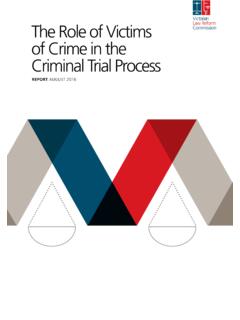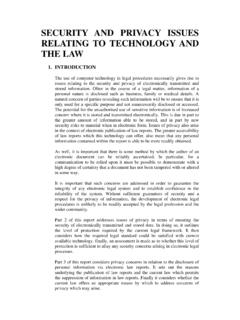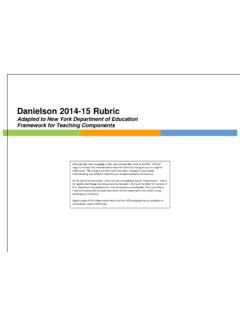Transcription of HOW AND WHY PEOPLE MAKE RULES LESSON PLAN
1 teacher GuideLevelLearning AreaStrandTopic3 & 4 Humanities: civics and citizenshipLaws and CitizensRulesOverviewThe aim of this LESSON plan is to give teachers a range of ideas and activities to: facilitate student understanding of the importance of RULES in our community encourage student engagement with civics LinksVictorian Curriculum F-10 LevelLearning AreaStrandsCurriculum Code3 & 4 Humanities: civics and citizenship Laws and Citizens Explain why PEOPLE make RULES Discuss why RULES are importantVCCCL004 VCCCL005 CapabilitiesStrandCurriculum CodeCritical and creative thinking Meta-Cognition Consider concrete and pictorial models to facilitate thinking, including a range of visualisation strategiesVCCTM018 Learning GoalsBy the end of these lessons, students will be able to: Identify different types of RULES Understand why we have RULES Discuss the importance of rulesResources and MaterialsIncluded with this LESSON plan are: teacher guide teacher instructions: learning activitiesHOW AND WHY PEOPLE MAKE RULESLESSON PLAN Challenges of being a leader worksheet Reflection worksheet Compare worksheetLearning Activities SummaryThese activities meet the needs of students working towards attainment of the Victorian Curriculum F-10 in Levels 3-4 in civics and Citizenship.
2 This LESSON plan contains the following learning activities and resources: 1. Warm-up brainstorm: Why do we have RULES ?2. Think / Pair / Share 3. Class discussion: How and why do we have RULES ?4. Storytime5. Storytime: Share6. Storytime: Discuss7. Storytime: Reflection8. Exit pass: Why do PEOPLE make rules9. Extension: Comparing how RULES can be similar and differentAchievement StandardBy the end of these lessons students will meet the achievement standards in Levels 3 and 4 in civics and Citizenship by being able to: Explain how and why PEOPLE make RULES Discuss why RULES are importantLesson plan for teachersLearning intention Explain how and why PEOPLE make RULES Discuss why RULES are importantSuccess Criteria1. I can talk about how and why PEOPLE make rules2. I have some ideas about how or why PEOPLE make rules3. I m confused about why RULES are a thingTerminologyRulesSafetyFairnessProte ctionLawVoting1.
3 WARM-UP BRAINSTORM: WHY DO WE HAVE RULES ?Start by having a list of class RULES on the whiteboard (or use google image of traffic signs).Ask the class: why do we have class RULES ? write down key words or ideas on the board as a the class: Why do we have school RULES ? in a different colour, write down any new key words or ideas on the THINK / PAIR / SHAREFor the following question, use a Think / Pair / Share technique (students think about their own ideas first, then they have 30 seconds to share their ideas with the person sitting next to them, then the teacher chooses some pairs to report back to the class about what they discussed). Stress that there are no correct answers. What is one rule you love and one you hate at home? Why?- Tease out fairness (eg sister not in my room), safety (eg don t touch the stove).HOW AND WHY PEOPLE MAKE RULESACTIVITIES3.
4 CLASS DISCUSSION: HOW AND WHY DO WE HAVE RULES ?Have a class discussion around the questions why do we have RULES ; how do we make RULES . The purpose of the discussion is to tease out that safety, fairness, equality and consequences are all part of having RULES . Use the below prompts to explore the different parts of rulemaking: If someone new comes into our class, how do they know the RULES ? Why do they need to know the RULES ? What happens if our RULES aren t followed? Mind map as class How did we make our RULES ? Are all RULES made like that? Possible responses: Vote, suggestion, one person decides4. STORY TIMEYou are King or Queen of an island. There are other PEOPLE on the island, but you re in charge. What RULES would you make and why? (could put stimulus image up to assist) How would you make the RULES ? How would you make PEOPLE follow the RULES ?
5 What would happen if they didn t? Is it different for each rule? Sentence stems on board Possible to list or as a table rather than story Possible to draw the island discuss signs, colours that mean yes or no, symbols Possible to dot point on butchers paper as a group5. STORY TIME SHARES hare story with others pairs, swap in a circle around table, as a class STORY TIME DISCUSSWhat were any common RULES mind map (as table or class)Why are they common? Safety, fairnessDid anyone have a rule you wish you had? What was it and why?7. STORY TIME REFLECTIONTask: Complete sentence stems in the attached worksheet:Some PEOPLE make RULES good rule to help keep PEOPLE safe good rule in the classroom to be fair rule can be made EXIT PASS: WHY DO PEOPLE MAKE RULES ?Students write a number with their reflection response to show their understanding and measure their personal I can talk about how and why PEOPLE make rules2.
6 I have some ideas about how or why PEOPLE make rules3. I m confused about why RULES are a thing9. EXTENSION: COMPARING HOW RULES CAN BE SIMILAR AND DIFFERENTO ption oneComplete a venn diagram to show how RULES at home and RULES at school can be similar and twoComplete the worksheet diagram to show similarities and differences between RULES at home and at school. Once the diagram is complete, use think pair share to discuss how their results may be different to someone plan for teachersLearning intention Explain how and why PEOPLE make RULES Discuss why RULES are importantSuccess Criteria1. I can talk about how and why PEOPLE make rules2. I have some ideas about how or why PEOPLE make rules3. I m confused about why RULES are a thingTerminologyRulesSafetyFairnessProte ctionLawVoting1. WARM-UP BRAINSTORM: WHY DO WE HAVE RULES ?
7 Start by having a list of class RULES on the whiteboard (or use google image of traffic signs).Ask the class: why do we have class RULES ? write down key words or ideas on the board as a the class: Why do we have school RULES ? in a different colour, write down any new key words or ideas on the THINK / PAIR / SHAREFor the following question, use a Think / Pair / Share technique (students think about their own ideas first, then they have 30 seconds to share their ideas with the person sitting next to them, then the teacher chooses some pairs to report back to the class about what they discussed). Stress that there are no correct answers. What is one rule you love and one you hate at home? Why?- Tease out fairness (eg sister not in my room), safety (eg don t touch the stove).HOW AND WHY PEOPLE MAKE RULESACTIVITIES3. CLASS DISCUSSION: HOW AND WHY DO WE HAVE RULES ?
8 Have a class discussion around the questions why do we have RULES ; how do we make RULES . The purpose of the discussion is to tease out that safety, fairness, equality and consequences are all part of having RULES . Use the below prompts to explore the different parts of rulemaking: If someone new comes into our class, how do they know the RULES ? Why do they need to know the RULES ? What happens if our RULES aren t followed? Mind map as class How did we make our RULES ? Are all RULES made like that? Possible responses: Vote, suggestion, one person decides4. STORY TIMEYou are King or Queen of an island. There are other PEOPLE on the island, but you re in charge. What RULES would you make and why? (could put stimulus image up to assist) How would you make the RULES ? How would you make PEOPLE follow the RULES ? What would happen if they didn t?
9 Is it different for each rule? Sentence stems on board Possible to list or as a table rather than story Possible to draw the island discuss signs, colours that mean yes or no, symbols Possible to dot point on butchers paper as a group5. STORY TIME SHARES hare story with others pairs, swap in a circle around table, as a class STORY TIME DISCUSSWhat were any common RULES mind map (as table or class)Why are they common? Safety, fairnessDid anyone have a rule you wish you had? What was it and why?7. STORY TIME REFLECTIONTask: Complete sentence stems in the attached worksheet:Some PEOPLE make RULES good rule to help keep PEOPLE safe good rule in the classroom to be fair rule can be made EXIT PASS: WHY DO PEOPLE MAKE RULES ?Students write a number with their reflection response to show their understanding and measure their personal I can talk about how and why PEOPLE make rules2.
10 I have some ideas about how or why PEOPLE make rules3. I m confused about why RULES are a thing9. EXTENSION: COMPARING HOW RULES CAN BE SIMILAR AND DIFFERENTO ption oneComplete a venn diagram to show how RULES at home and RULES at school can be similar and twoComplete the worksheet diagram to show similarities and differences between RULES at home and at school. Once the diagram is complete, use think pair share to discuss how their results may be different to someone GuideThe below are examples of student samples of work for their story. They include an island built on minecraft and then discussed verbally; a short story by a queen of an island and a sign with short responses of :If I was queen of this Island first I would make a rule that no one can go outside after dark without getting my Ok. I would make this rule so they stay safe and monsters don t hurt would make the RULES on my own.









